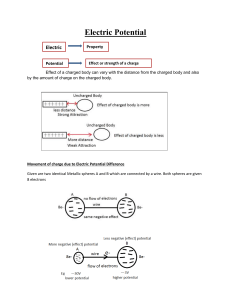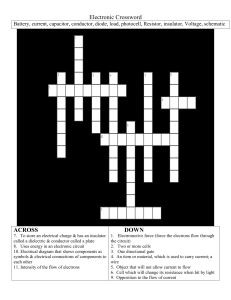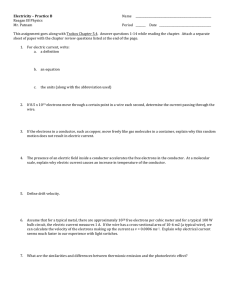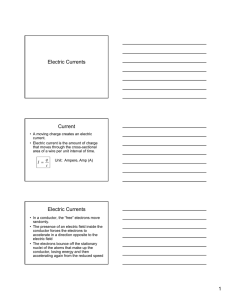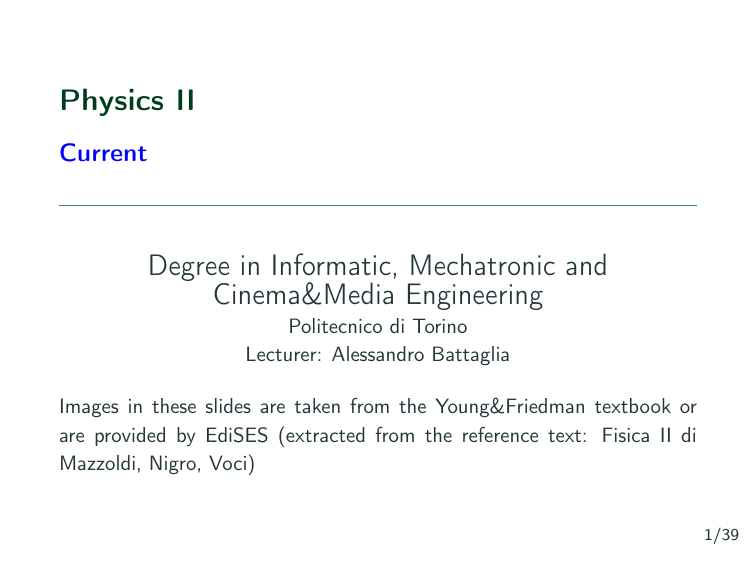
Physics II Current Degree in Informatic, Mechatronic and Cinema&Media Engineering Politecnico di Torino Lecturer: Alessandro Battaglia Images in these slides are taken from the Young&Friedman textbook or are provided by EdiSES (extracted from the reference text: Fisica II di Mazzoldi, Nigro, Voci) 1/39 Learning outcomes 1. The meaning of electric current, and how charges move in a conductor. 2. What is the continuity equation 3. What is meant by the resistivity and conductivity of a substance. 4. How to calculate the resistance of a conductor from its dimensions and its resistivity. 5. How an electromotive force (emf) makes it possible for current to flow in a circuit. 2/39 Free electrons in a conductor The number of free electrons per unit of volume in a metallic conductor coincides with the number of atoms (if there is one free e − per atom): n= NA ρ A where NA is the Avogadro number, ρ is the density and A is the mass number 3/39 Free electrons in a conductor: numerical example n= NA ρ A In copper: n= 6.022 · 1026 · 8.96 · 103 = 8.49 · 1028 electrons/m3 63.55 In silver: n= 6.022 · 1026 · 10.5 · 103 = 5.86 · 1028 electrons/m3 107.87 4/39 Conductor in electrostatic conditions vm = 1 X vi = 0 N i In electrostatic situations the electric field is zero everywhere within the conductor, and there is no current (but electrons are moving around at speed of the order of 106 m/s!). 5/39 Electrical conduction Two isolated conductors C1 and C2 at potential V1 and V2 put into contact become a conductor at the same potential. Electrons pass from the conductor with a lower potential to that with a higher potential under the action of an electric field associated with the d.d.p. EMF generator = device capable of maintaining a ∆V between two points of the same conductor. 6/39 Conductor with internal electric field If an electric field E is present, the electric E imposes force F = qE a small drift (greatly exaggerated) that takes the electron to point P20 a distance vd ∆t from P2 in the direction of the force. 7/39 Definition of current The same current can be produced by: (a) positive charges moving in the direction of the electric field E ; (b) the same number of negative charges moving at the same speed in the direction opposite to E . The current through the crosssectional area Σ is defined as the net charge flowing through the area per unit time: i= dq dt 8/39 Current and Drift Velocity We can express the current in terms of the drift velocity of the moving charges i= dq ∆q = lim ∆t→0 ∆t dt cos θ dΣ is the area orthogonal to E k vd dτ = vd ∆t dΣ cos θ volume swept by moving charges ∆q = n+ e dτ = n+ e vd cos θ dΣ ∆t charge flowing trough Σ di = n+ e vd dΣcosθ 9/39 Current, Drift Velocity and Current Density di = n+ e vd dΣcosθ j = n+ evvd di = j · un dΣ Z j · un dΣ = ΦΣ (jj ) iΣ = Σ 10/39 Current Density ↔ electric current When the surface Σ is orthogonal to j and j has the same value on all points of Σ: i = jΣ j= i Σ the current density is the current flowing through a unit surface whose normal is perpendicular to the direction of the charge motion. 11/39 Direction of current density If, as in metals, the charge carriers are negative: j = −n− evv− If, on the other hand, there are carriers of the two signs (as in semiconductors or ionic solutions): j = n+ evv + − n− evv − The two contributions are in the same direction: k E . It is not possible to determine the sign of the charge carriers from the direction of the current Convention: the current density is directed along the motion of the positive charges. 12/39 Units Units for current is the Ampere: A= C s Ampere is one of the seven SI base units. Units for current density is: [j] = A m2 13/39 Multiple choice test The electric field, E , when expressed in SI base units is measured in: (A) kg m2 s −1 A−1 (B) kg m s −2 A−2 (C) kg m2 s −3 A−1 (D) kg m s −3 A−1 14/39 Answer [E ] = [F ] Nt kg ms −2 kg ms −3 = = = = kg m s −3 A−1 [Q] C C C /s Answer: D 15/39 Current density versus current Current density is a vector, current is not. The current density describes how charges flow at a certain point, and the vector’s direction tells you about the direction of the flow at that point. By contrast, the current describes how charges flow through an extended object such as a wire. i has the same value at all points in the circuit on the right, but j does not: the current density is directed downward in the left-hand side of the loop and upward in the right-hand side. 16/39 Law of charge Conservation The total charge that passes in the unit time through the closed surface Σ is: I i= j · un dΣ Σ I j · un dΣ = − i= Σ ∂qint ∂t 17/39 Charge continuity equation Z qint = ρdτ τ I ∂qint j · un dΣ = − ⇒ ∂t Σ I Z j · un dΣ = − Σ Z j · un dΣ = Σ I τ ∂ρ dτ ∂t (Divergence theorem) ∇ · j dτ τ Z ∂ρ ∇·j + dτ = 0 ∂t τ ∀τ ⇒ ∇·j + ∂ρ =0 ∂t 18/39 Stationary conditions If inside the closed surface Σ the charge does not vary, then I ∂ρ ∂t = 0: j · un dΣ = 0 ∇·j = 0 In stationary conditions the vector field j is solenoidal or an incompressible vector field. 19/39 Current carrying conductor in stationary conditions The grey volume represents a wire with cross sections changing with distance. There is no flux of j through the lateral surfaces. I Z j · un dΣ = Z j1 · u1 dΣ1 + Σ1 j2 · u2 dΣ2 = 0 Σ2 Z Z j2 · u2 dΣ2 = − Σ2 j1 · u1 dΣ1 Σ1 i1 = i2 20/39 Electromotive force If a charge goes around a complete circuit and returns to its starting point, the potential energy must be the same at the end of the round trip as at the beginning. Since there is always a decrease in potential energy when charges move through an ordinary conducting material with resistance there must be some part of the circuit in which the potential energy increases (typically a battery). Steady current in a complete circuit: analogous to an ornamental water fountain that recycles its water ⇒ a pump is needed that lifts the water back to the top (increasing the potential energy). Without the pump, the water would just fall to the basin at the bottom and 21/39 stay there. Theory of Metallic Conduction: no E field Drude (1900) and Lorentz (1906). • each atom is part of a crystal lattice and gives up one or more of its outer electrons (e − ); • e − move through the lattice in a completely disordered way. • e − undergo continuous interactions (= collisions) with ions; between successive collisions the motion is free and the trajectory is straight with v ≈ 106 m/s (Fermi’s theory). • The set of trajectories is completely random and there is no net charge flow: i = 0. • Between collisions the e − travels an average free path ` in an 22/39 average time τ (≈ 3 · 10−14 s for Cu at T = 300 K ): Theory of Metallic Conduction: presence of E field τ = `/v v i+1 = v i − eE τ me When averaging over a large number of electrons, N vd = N N 1 X 1 X eE v i+1 = vi − τ N N me i=1 mean drift velocity i=1 Since after each collision the mean velocity of the electrons is zero P i vi = 0 e τ vd = − E me (≈ mm/s) e τ ≈ 0.5 × 10−2 C s kg −1 me 23/39 Multiple choice test When applying an electric field E : (A) Each electron acquires an acceleration opposite to the E field and moves between one collision and the next between parabolic arcs. (B) Each electron acquires an acceleration opposite to the E field and moves between one collision and the next between rectilinear arcs. (C) Each electron acquires an acceleration concordant with the field E and moves between one collision and the next between rectilinear arcs. (D) Each electron acquires an acceleration concordant with the field E and moves between one collision and the next between parabola arcs. 24/39 Answer E /m a = F /me = −eE The motion is parabolic as it is accelerated along E and at a constant velocity in the orthogonal plane at E . Answer: A 25/39 Ohm’s law: conductivity j = −n− evvd = σ= n− e 2 τ me n− e 2 τ E me conductivity [C 2 s/(kg m3 ) = Ω−1 m−1 ] σ ≈ 108 Ω−1 m−1 for copper at ambient temperatures σ ≈ 10−16 ÷ 10−12 Ω−1 m−1 for insulators. E j = σE 26/39 Multiple choice test A conductor wire is connected to a generator which maintains a potential difference ∆V between the two extremes. How does the drift speed vd of the electrons vary if: a) the potential difference is doubled; b) the length of the wire is doubled; c) the section of the wire is doubled, ceteris paribus. (A) (B) (C) (D) doubles in a), b) and c). doubles in a), halves in b) and does not change in c). does not change in a) and c), it is halved in c). doubles in a) and c), halves in b). 27/39 Answer ⇒ j = −n− evvd E j = σE ⇒ vd ∝ j vd ∝ E If I double ∆V (when keeping the wire length constant) E doubles If I double the length of the wire (when keeping ∆V constant), E is halved If I double the section (when keeping ∆V constant) E remains unchanged. Answer: B 28/39 Ohm’s law: resistivity The previous equation can also be written: E = ρjj ρ= 1 me = σ n− e 2 τ resistivity of the material 29/39 Ohm’s law: generic charge carriers v+ = e τ+ E m+ v− = − j = n+ evv+ − n− evv− = e σ= 2 e τ− E m− n+ τ+ n− τ− + m+ m− E n+ e 2 τ+ n− e 2 τ− + m+ m− E j = σE 30/39 Ohm’s law: electric resistance If a d.d.p. (VA − VB ) is applied through the cylindrical metallic conductor with constant section Σ then a current flows: 1 E j = E = σE ρ in stationary regime: E ρ i = jΣ = Σ ⇒ E = i ρ Σ 31/39 Ohm’s law: electric resistance Z B V = VA − VB = E · dss = Eh A V = V = Ri ρh i Σ with R≡ρ h Σ Resistance is measured in Ohm: Ω = V A 32/39 Thermal effects In metallic conductors, if the temperature increases, the collision time τ decreases; correspondingly σ decreases or ρ increases. In insulators and semiconductors, the increase in temperature produces an increase in free carriers and therefore an increase of σ (decrease of ρ). ρ = ρ20 ◦ C (1 + α∆T ) The α coefficient, called thermal coefficient of resistivity is defined as: α= 1 ρ20 ◦ C ∆ρ ∆t 33/39 Power associated to Joule effect E to keep the single charge in The power spent by the force F = eE motion with velocity at v d is: E · vd Pe − = F · vd = eE The power spent per unit of volume (W /m3 ) is: Pτ = n− Pe − = E · n− evvd = E · j E we get: and from the relationship j = ρ1 E = σE Pτ = σE 2 = ρj 2 34/39 Joule’s effect Pτ = σE 2 = ρj 2 The total power that must be spent to circulate the electric current i in a section of conductor with section Σ and along h is obtained from: P = Pτ Σh = ρ i2 h Σh = ρi 2 Σ2 Σ P = R i2 = V i 35/39 Joule’s effect The same result is also obtained by considering the work performed by the field to move an infinitesimal charge dq between one point of the conductor at the potential VB to another at potential VA . For this displacement the work done is: dW = V dq = V i dt and the power is then calculated as: P= dW = Vi dt 36/39 Joule’s effect: summary The power spent to circulate the electric current i in the circuit is: P = Ri 2 = Vi = V2 R If you keep the current for a time t then the work done: Z t Z t W = Pdt = R i 2 dt 0 0 37/39 Multiple choice test A washing machine and a vacuum cleaner absorb a power of 2 kW and 1.3 kW respectively. Which of the two appliances has the greatest electrical resistance? In which one circulates the most current? (A) The washing machine has more resistance and more current flows in the vacuum cleaner. (B) The washing machine has more resistance and more current flows in the washing machine. (C) The vacuum cleaner has more resistance and more current flows in the vacuum cleaner. (D) The vacuum cleaner has more resistance and more current flows in the washing machine. 38/39 Answer V2 R As the power grid sustains potential differences of 220 V then the vacuum cleaner (which draws less power) will have a greater resistance. P= P = Vi So the washing machine (which draws more power) will have a higher current. Answer: D 39/39
